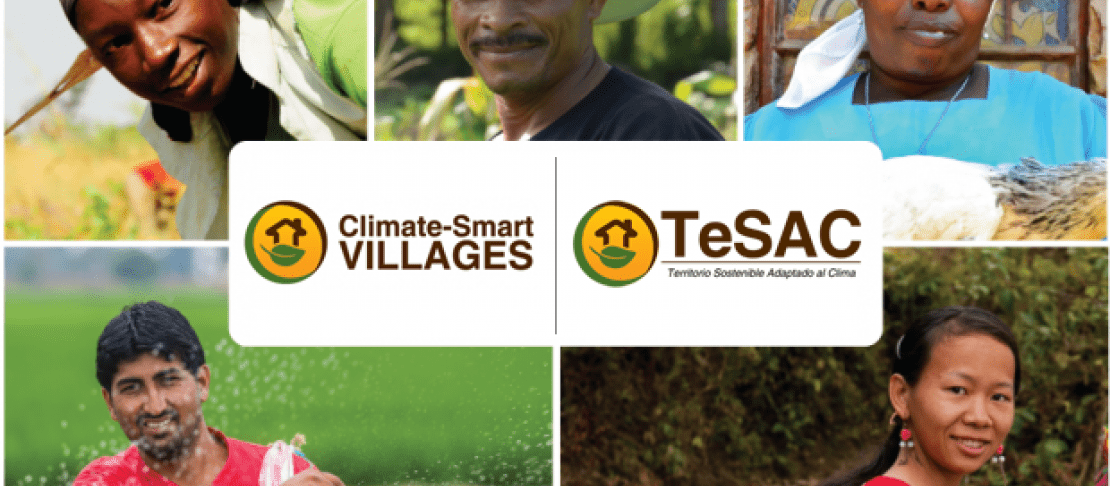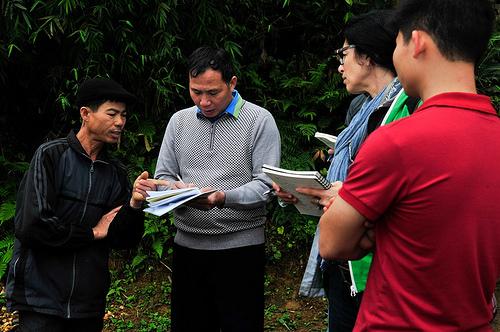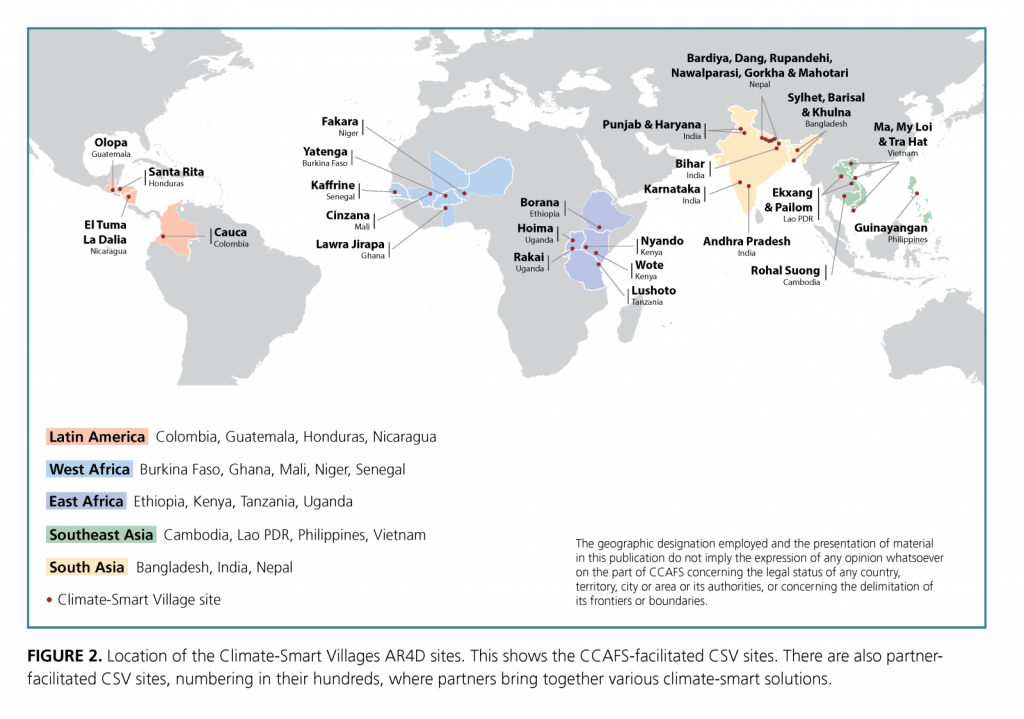
Practical adaptation options to improve food security and resilience
What practical steps can smallholder farmers take to adapt their agricultural practices to secure dependable food supplies and livelihoods? And can they do this while also decreasing greenhouse gas emissions or increasing carbon sequestration, thereby decreasing future climate change?
In a search for answers the CGIAR Research Program on Climate Change, Agriculture and Food Security (CCAFS) is working with a vast range of partners to test a range of interventions in climate-smart villages (CSV).

WORKSHOPS AND TOWN HALL MEETINGS ARE THE FIRST STEP TOWARDS BUILDING A CLIMATE-SMART VILLAGE. Photo: G. Smith (CIAT)
Project Process
The CSV project launched in 2011 with 15 climate-smart villages in West Africa, East Africa and South Asia. Additional villages are now being chosen in Latin America and Southeast Asia.
All the villages are in high-risk areas, which will likely suffer most from a changing climate. Villages are also locations where partners have already established vital links with local communities.
Where we work
- East Africa: Nyando, Wote (Kenya), Hoima, Rakai (Uganda), Lushoto (Tanzania) and Borana (Ethiopia).
- West Africa: Yatenga (Burkina Faso), Lawra-Jirapa (Ghana), Cinzana (Mali), Fakara (Niger), Kaffrine (Senegal).
- Latin America: Cauca (Colombia), Olopa (Guatemala), Santa Rita (Honduras).
- South Asia: Kuhlna, Barishul, Sylhet (Bangladesh), Rupandehi, Mahotari, Nawalparasi, Dang, Barisal, Gorkha (Nepal), Haryana, Bihar, Punjab, Andra Pradesh and Karnataka (India).
- Southeast Asia: Ma in Yenbai Province, My Loi in Ha Tinh Province and Tra Hat in Bac Lieu Province (Vietnam), Ekxang in Vientianne Province and Banh Pailom in Savannakhet Province (Lao PDR), Rohar Sourng in Battam bang Province (Cambodia) and Guinayangan (Philippines).

After potential sites are selected, a steering group of community representatives and researchers together identify appropriate climate-smart options for that village. These might include climate-smart technologies, climate information services, local development and adaptation plans and supportive institutions and policies, all tailored to that community’s needs. The community chooses its preferred options in a process that aims to be as participatory and inclusive as possible, encouraging women and more vulnerable groups to participate.
In Kenya, for example, more than 1,100 households in the climate-smart villages joined self-help groups established by the project to support the communities, and 70–85% of the active members of the groups are women.
Interventions that deliver
In Kenya’s Lower Nyando valley, farmers are discovering the value of agroforestry, with alleys of maize, sorghum and other crops sandwiched between rows of multi-purpose trees that stabilize and enrich the soil. What’s more, demand for trees has led to nurseries springing up to supply tree seedlings.
These nurseries in turn are becoming an important source of income, particularly for women, who own more than half of the 22 nurseries now thriving in Lower Nyando. Working with farmers to incorporate small livestock, such as poultry, sheep and goats, into their farms brings additional resilience, income and food security.
Climate-Smart Services
In addition to farm practices, farmers in climate-smart villages are also testing climate-smart services, such as tailored weather forecasts to plan planting, harvesting and other activities on the farm. Advisories and weather forecasts are being delivered by mobile phones, and phones are also being used to enable farmers to buy index-based insurance that gives them a measure of protection in the event of extreme weather.
Spreading the word
The approach of climate-smart villages is tailored, rather than one-size-fits-all, and there is enormous scope for learning from what works in one site and adapting it for others, an approach the project calls “knowledge smart”. For example, farmers from Lawra-Jirapa, a climate-smart village in Ghana, visited Yatenga, a climate-smart village in Burkina Faso, because the CCAFS Climate Analogues tool indicated that Yatenga farmers were experiencing today conditions that the Ghanaian farmers could expect in the future. The Ghanaians were able to learn first-hand about the crops and techniques that their Burkinabe colleagues currently use.
Training-the-trainers is another essential element in farmer learning networks, and has proved its worth in Bihar. CCAFS partners Alternative Futures and Mahila Samakhya, a national programme dedicated to empowering women, trained a core group of elected women who then took the message to more than 1500 additional women across the state. Crucially, many of the women trainers adapted the messages to be more appropriate to their local culture, turning them into songs because that is how women convey, share and remember important information.
One of the great strengths of the climate-smart villages approach is its inclusiveness. Farmers from different communities, researchers from different disciplines, non-governmental organizations and other partners, all come together to test a range of options in an integrated fashion. Efforts to date show how food security and resilience can be improved in the face of climate change and at the same time suggest ways in which smallholders in all sorts of communities can adapt their agriculture.